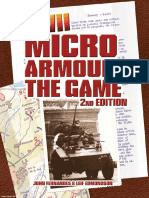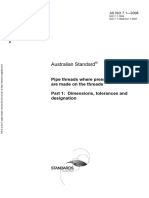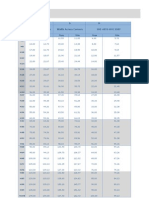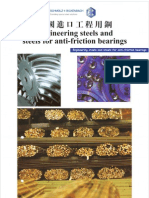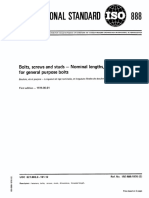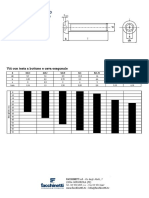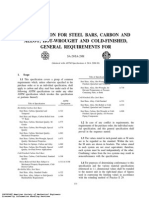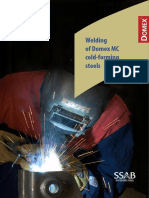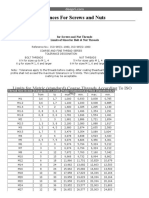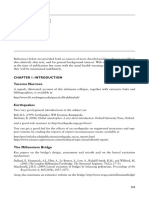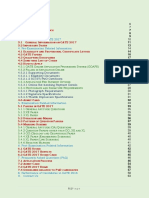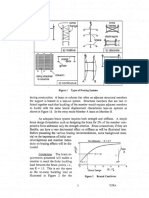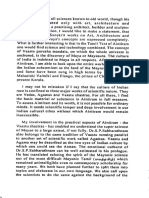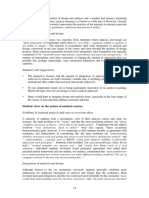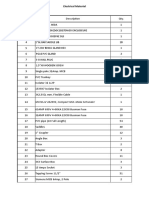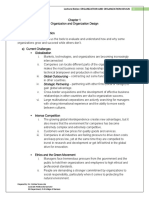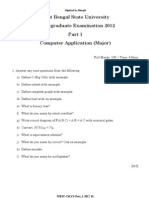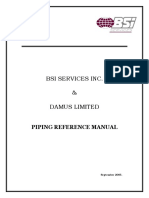Screw Thread Calculations
Screw Thread Calculations
Uploaded by
bagmassCopyright:
Available Formats
Screw Thread Calculations
Screw Thread Calculations
Uploaded by
bagmassOriginal Description:
Copyright
Available Formats
Share this document
Did you find this document useful?
Is this content inappropriate?
Copyright:
Available Formats
Screw Thread Calculations
Screw Thread Calculations
Uploaded by
bagmassCopyright:
Available Formats
Screw thread Calculations
1 of 4
http://www.roymech.co.uk/Useful_Tables/Screws/Thread_Calcs.html
Disclaimer: The information on this page has not been checked by an independent person. Use this information at your own risk.
ROYMECH
from one of Europes most specia lised suppliers for screws & nuts.
Click arrows to page adverts
These Pages include various standards. To confirm the status of any standard, identify the replacement standard if it is obsolete and/or purchase
the standard please use.
BSI Shop
It is also possible to become a BSI member and obtain copies of the Standards at much reduced prices.
Home
Screws Index Page...
Screw Stress Areas
Introduction
The critical areas of stress of mating screw threads are
The effective cross section area, or tensile area, of the external thread.
The shear area of the external thread which depends upon minor diameter of the tapped hole
The shear area of the internal thread which depends on the major diameter of the external thread
The allowable stresses and screw end force and the method of applying the force in the calculation of the tensile stress are not considered on this
page but are addressed on this site by tables and more importantly referenced links
If a screw threaded fastener is to fail it is preferable that the screw fails rather than the internal or external thread strips. The length of the screw
engagement should therefore be sufficient to carry the full load necessary to break the screw without the threads stripping.
The size of a screwed fastener is first established by calculating the tensile load to be withstood by the screw and selecting a suitable screw to
withstand the tensile load with the appropriate factor of safety or preload. If the joint is fixed using a nut and bolt then assuming the nut is selected
from the same grade as the bolt there is little need to size the nut. The fastener manufacture sizes the length of the nut to ensure the screw will fail
before the nut. If the screw fastens into a tapped hole then a check of the depth of thread engagement is required.
Generally for female and male threads of the same material with, the female thread is stronger than the male thread in shear for the same length of
engagement
The following rules of thumb are suggested for arriving at reasonable lengths of thread for steel screws used with screwed holes in weaker
materials.
For steel a length of thread engagement of at least 1 x Nominal dia's of the thread
For Cast Iron or brass or bronze the thread engagement should be at least 1,5 x Nominal dia's of the thread
For Aluminium , zinc or plastices the thread engagement should be at least 2 x Nominal dia's of the thread
However for a quality safe connection, when the tapped material has a significantly lower ultimate tensile strength than the screw material, - to
ensure the screw will fail in tension before the female, it is preferable to use suitably rated nuts or engineered thread inserts.
For some notes on thread Inserts ref. Thread Inserts
Important Note:
Various studies on thread loading have established that the shear stress is not evenly distributed across the threads. The first
thread withstanding the load is the highest stressed and the next one is much less stressed and so on... . If the thread
materials were very hard and did not yield the first thread could be withstanding nearly all the load. However because of
material yielding there is some distribution of the load. A study (see link 2 below) has established that for a typical grade 8 nut
the percentage of the load taken by consecutive threads are about 34%, 23%, 16%,11%,9%, 7% .... This effect can be alleviated
by using very accurate threads and by using ductile materials for the components. It has been established that,for carbon steel,
there is no increase in thread shear strength by having a thread engagement length in excess of the screw diameter. It is
normal practice to use a tapped hole depth of about 1,5 x nominal diameter - this allows at least 1 diameter of good thread
engagement.
A very simple rule that can be applied for that vast majority of applications is that a thread length of 80% of the screw diameter
(standard nut height) is sufficient for ensuring that the screw will fail in tension before the female thread (nut) fails in thread
stripping (assuming the screw and nut are similar materials). Equations below indicate how to make adjustments if the tapped
metal (nut) strength is lower than the screw/bolt.
Stress Area formulae
D = Basic Diameter.
p = Screw Thread Pitch
6/16/2015 10:54 AM
Screw thread Calculations
2 of 4
http://www.roymech.co.uk/Useful_Tables/Screws/Thread_Calcs.html
Le = Length of Thread Engagement
A t = The screw thread tensile stress area
d p = Pitch circle diameter of thread
A ss =The thread shear area
The following formula for the Tensile Stress Area of the (male) screw
This is based on ISO 898 Part 1. see calculation below..
d p = Pitch circle diameter of thread
dp = (D - 0.64952.p )
The thread shear area = Ass
When the female and male threads are the same material.
Ass = 0.5. . dp. Le = 0.5 (D - 0.64952.p ). Le
To ensure that the screw fails before the thread strips it is necessary the the shear area is at least 2 times the tensile area. i.e
Le (min) = 2 . A t / [0.5 . .(D - 0.64952.p )]
This assumes that the male and female thread materials have the same strength. If the Female Material strength is lower i.e J as calculated below is
greater than 1 then the length of engagement must be increased to prevent the female thread stripping
If the value of J is greater than than 1 then the length of engagement must be increased to at least
More Detailed Notes
The above formulae are sufficient to enable the tensile strength to be calculated and to allow the depth of thread to be confirmed for a tapped hole
Following are equations to provide more accurate evaluation of the shear strength of threads. These are equations derived from FED-STD-H28/2B,
1991 and Machinerys Handbook eighteenth Edition. They strictly apply to UN thread series but if the relevent metric screw thread dimensions are
used they will give reasonable results. In practice when the values are calculated the value for the screw shear strength is similar to the very
convenient formula provided above. These equations are only of theoretical value
Screw Shear Area Calculations
K nmax = Maximum minor diameter of internal thread.
E smin = Minimum pitch dia of external thread.
E nmax = Maximum pitch dia of internal thread.
D smin = Minimum major dia of external thread.
n = 1/p = threads per unit (mm)
Minimum Length Of Thread (Assuming male and female threads are materials of similar strength).
Shear Area For Screw
Shear Area For Female Thread
If material in which the female thread is tapped is significantly weaker that the screw material then J must be evaluated.
6/16/2015 10:54 AM
Screw thread Calculations
3 of 4
http://www.roymech.co.uk/Useful_Tables/Screws/Thread_Calcs.html
If the value of J is greater than than 1 then the length of engagement must be increased to at least
Stress area -ISO 898
Note: Short derivation of nominal stress area formula from info in BS EN ISO 898..
Some calculated Stress Areas for ISO Metric Threads..medium fit (6H / 6g)
The purpose of this table is to show the results of the above formula. It is clear from this table that there is no major benefit in using the detailed
formula above. The approximate formula for the screw thread shear stress area (A ss) is generally sufficiently accurate and there is no need to use
the more detailed formula for As. For sizes below M6 the formulas yield very similar values. For sizes M6 and above the value for Ass provides a
slightly more conservative result (20% margin at M36)
I have obtained the thread dimensions on tables in Machinery's Handbook 27th ed. If you intend to use this information please check it against a
reliable source (ref disclaimer above)
All dimensions in mm
Size
Basic Dia
M3
M4
M5
M6
M8
M10
M12
M14
M16
M20
M22
M24
M30
M36
D (mm)
3.00
4.00
5.00
6.00
8.00
10.00
12.00
14.00
16.00
Pitch
0.50
0.70
0.80
1.00
1.25
1.50
1.75
2.00
2.00
1/p
2.0000 1.4286 1.2500 1.0000 0.8000 0.6667
0.5714 0.5000
0.5000
Stress Dia
Ds
2.5309 3.3433 4.2494 5.0618 6.8273 8.5927
10.3582 12.1236 14.1236
Tensile
Stress
Area
At
5.0308 8.7787 14.1825 20.1234 36.6085 57.9896 84.2665 115.4394 156.6684 244.7944 303.3993 352.5039 560.5872 816.7226
Pitch
circle dia.
dp
2.6752 3.5453 4.4804 5.3505 7.1881 9.0257
10.8633 12.7010 14.7010
20.00
22.00
24.00
30.00
2.50
2.50
3.00
3.50
4.00
0.4000
0.4000
0.3333
0.2857
0.2500
17.6545 19.6545 21.1854 26.7163
36.00
32.2472
18.3762 20.3762 22.0514 27.7267
33.4019
28.8653 32.0069 34.6383 43.5530
52.4676
Approximate Method
Shear
Area/unit
Length
Ass/mm
Shear
Area
Assm
=2. At
4.2023 5.5690 7.0378 8.4045 11.2910 14.1776 17.0641 19.9506 23.0922
10.0616 17.5574 28.3650 40.2468 73.217 115.9792 168.533 230.8788 313.33568 489.5888 606.7986 705.078 1121.1744 1633.4452
Length of
Le =
Thread
2.3944 3.1527 4.0304 4.7887 6.4845 8.1805
(Ass=2*At) Ass /A ss/mm
9.8765 11.5725 13.5689
16.9612 18.9584 20.3534 25.7428
31.1324
More Accurate Method
Max.Minor
Dia (nut)
Knmax
2.5990 3.4220 4.3340 5.1530 6.9120 8.6760
10.4410 12.2100 14.2100
17.7440 19.7440 21.2520 26.7710
32.2700
Min Pitch
Dia
(Screw)
E smin
2.5800 3.4330 4.3610 5.2120 7.0420 8.8620
10.6790 12.5030 14.5030
18.1640 20.1640 21.8030 27.4620
33.1180
Max Pitch
E sub>nmax 2.7750 3.6630 4.6050 5.5000 7.3480 9.2060
dia (Nut)
11.0630 12.9130 14.9130
18.6000 20.6000 22.3160 28.0070
33.7020
Min Major
dia
(Screw)
11.7010 13.6820 15.6820
19.6230 21.6230 23.5770 29.5220
35.4650
D smin
2.8740 3.8380 4.8260 5.7940 7.7600 9.7320
6/16/2015 10:54 AM
Screw thread Calculations
4 of 4
http://www.roymech.co.uk/Useful_Tables/Screws/Thread_Calcs.html
Shear
Area/unit
length
(Screw)
A s /mm
3.9034 5.4728 7.0731 8.6458 12.1612 15.5796 18.9762 22.4239 26.0969
33.2791 37.0302 40.4623 51.6384
63.0982
Shear
Area /mm
length
(Nut)
A n/mm
5.5466 7.7691 9.9988 12.1909 16.8285 21.4769 26.1173 31.0335 35.5699
45.3881 50.0141 55.0098 69.5512
84.0601
Length of
Thread
(As= 2*At)
Le
2.5777 3.2081 4.0103 4.6551 6.0206 7.4443
14.7116 16.3866 17.4238 21.7120
25.8873
8.8813 10.2961 12.0067
Relevant Links
1. Bolt Science..A site dedicated to the Science & Technology of bolted joints
2. F.E.D.S Screw Thread design .A very useful and informative document- You must read this if you are doing detaile design.
3. Tribology-ABC Screw Joints metric Lots of very useful notes and calculators
4. Heli-coil Catalogue Wire thread Insert - the simple method of providing high thread strength with thread locking.
5. Bolted Joints..An informative paper published on the Web
6. Metric Bolt Strength..Bolt Sizes Strengths- American bias
7. Croberts Com..Very useful section on the consequence of Bolt Failure
8. Fastener Design Manual...NASA GRC RP-1228 (9.6 Mbyte pdf file). Design info on bolt + rivet joints
9. Bolt Council Publications...->Guide to Design Criteria for Bolted and Riveted Joints.(6.7 Mbyte pdf file). Excellent ....
10. The yielding of fasteners during tightening...An article with surprising conclusions
11. Keeping It All Together ...Practical notes on bolted joints from an enthuiast
12. International Thread Standards .. A comprehensive set of thread tables including BSP
Ads by Google
Screw Threa
Metric Bolt
M
i S
This Page is being developed
Home
Screws Index Page...
Please Send Comments to Roy Beardmore
Last Updated 24/01/2013
6/16/2015 10:54 AM
You might also like
- Flanges SAE para Solda SN532-1Document5 pagesFlanges SAE para Solda SN532-1willianNo ratings yet
- En 12451 1999Document24 pagesEn 12451 1999victoraghiNo ratings yet
- ATA 71 Eng Operating LimitsDocument13 pagesATA 71 Eng Operating Limitsanarko arsipelNo ratings yet
- Summary Comparison of BS 4395 and BS EN 14399 3 6 PDFDocument12 pagesSummary Comparison of BS 4395 and BS EN 14399 3 6 PDFLakhwant Singh KhalsaNo ratings yet
- BS 1804 - Part 2 - 1968 - Parallel Steel Dowel Pins PDFDocument11 pagesBS 1804 - Part 2 - 1968 - Parallel Steel Dowel Pins PDFtheinNo ratings yet
- DIN en 1708-1-1999 Welding Basic Welded Joint Details in Steel Part 1 Pressurized ComponentsDocument73 pagesDIN en 1708-1-1999 Welding Basic Welded Joint Details in Steel Part 1 Pressurized Componentsmehmacar100% (2)
- BS 7644-1-1993Document13 pagesBS 7644-1-1993erik rainierNo ratings yet
- GT-OPTIMTM High Performance TrayDocument24 pagesGT-OPTIMTM High Performance Tray전아진No ratings yet
- Micro Armour The Game-WWII 2nd Edition (Full Color)Document136 pagesMicro Armour The Game-WWII 2nd Edition (Full Color)J.MichaelLooney67% (3)
- Structural Steel BoltsDocument7 pagesStructural Steel BoltsMark OglesbyNo ratings yet
- 7 1-2008Document8 pages7 1-2008SAI Global - APACNo ratings yet
- BOLLHOFF-Informatii Tehnice Generalitati PDFDocument106 pagesBOLLHOFF-Informatii Tehnice Generalitati PDFmugur_vasilescuNo ratings yet
- Astm C1513 18Document5 pagesAstm C1513 18Fatma AhmedNo ratings yet
- Anchor Bolt TolerancesDocument3 pagesAnchor Bolt TolerancesRam BabuNo ratings yet
- Iso 14 1982Document10 pagesIso 14 1982LotharSchmidtNo ratings yet
- Welding Instructions For Toolholders: Material Microalloyed Heat-Treatable Steel 34Mncrb4+TiDocument1 pageWelding Instructions For Toolholders: Material Microalloyed Heat-Treatable Steel 34Mncrb4+TiVetriselvan ArumugamNo ratings yet
- Link LookupDocument12 pagesLink LookupBobaru MariusNo ratings yet
- Astm A700 14 2019Document2 pagesAstm A700 14 2019MaryNo ratings yet
- L9 Fastening System PDFDocument6 pagesL9 Fastening System PDFMarcel BaqueNo ratings yet
- Sfa-5 18Document28 pagesSfa-5 18Armando Lujan VelazquezNo ratings yet
- Rules For Reusing BoltsDocument4 pagesRules For Reusing Boltsaataylor83No ratings yet
- Metric Heavy Hex Nut DimensionsDocument3 pagesMetric Heavy Hex Nut DimensionsSenthillkumar BalasubramaniamNo ratings yet
- Maryland Metrics Thread Data Charts Din 158: Pipe Thread - Metric Taper Pipe - MTDocument3 pagesMaryland Metrics Thread Data Charts Din 158: Pipe Thread - Metric Taper Pipe - MTngaltunokNo ratings yet
- Din 3760 KeçeDocument13 pagesDin 3760 KeçeUfuk YürekNo ratings yet
- Astm A193 A193m 23Document7 pagesAstm A193 A193m 23huicholeNo ratings yet
- Fastener Screw Thread Rolling DiametersDocument5 pagesFastener Screw Thread Rolling Diametersn1ghtfall100% (1)
- Influence of Gear Geometry On Gearbox Noise Reduction - An Experimental InvestigationDocument7 pagesInfluence of Gear Geometry On Gearbox Noise Reduction - An Experimental InvestigationsamanaveenNo ratings yet
- Engineering SteelsDocument2 pagesEngineering Steelsccocos7182100% (2)
- Iso 888 1976Document4 pagesIso 888 1976202218et490100% (1)
- Iso 7380Document1 pageIso 7380MarioNo ratings yet
- A307 PDFDocument5 pagesA307 PDFxaviereduardoNo ratings yet
- 010 Sa29 Sa29mDocument26 pages010 Sa29 Sa29mWeniton OliveiraNo ratings yet
- MTC - Specification PDFDocument16 pagesMTC - Specification PDFMathieu KaiserNo ratings yet
- Type BSDType CSD Self Drilling ScrewsDocument2 pagesType BSDType CSD Self Drilling Screwscheow jongNo ratings yet
- Pre-Load For BoltDocument6 pagesPre-Load For BoltJ.GuerhardNo ratings yet
- Print Web-2Document2 pagesPrint Web-2aries andhikaNo ratings yet
- Welding Styles: For Corner JointDocument3 pagesWelding Styles: For Corner JointSenyor MarananNo ratings yet
- ISO 8752 2009 (En)Document12 pagesISO 8752 2009 (En)harpreet singhNo ratings yet
- Screw Strength DocumentDocument3 pagesScrew Strength Documentmsiddiq1No ratings yet
- Is 1364 1 2002Document20 pagesIs 1364 1 2002harikrishnanmveplNo ratings yet
- Iso 887-2000Document10 pagesIso 887-2000BaoNo ratings yet
- DSI GEWI Threadbar System EMEA PDFDocument12 pagesDSI GEWI Threadbar System EMEA PDFjuan carlosNo ratings yet
- Is 3601 PDFDocument24 pagesIs 3601 PDFNagendra Kumar100% (1)
- BS 01726-2-2002Document18 pagesBS 01726-2-2002Joana Casta100% (1)
- Astm A325m PDFDocument8 pagesAstm A325m PDFDastaggir KarimiNo ratings yet
- Asme B18.12 2001Document19 pagesAsme B18.12 2001Jesse ChenNo ratings yet
- S For Quenching D Tentpering-: SteelDocument28 pagesS For Quenching D Tentpering-: SteelDidier LZNo ratings yet
- Fastener Tightening PDFDocument3 pagesFastener Tightening PDFAbdullah AnsariNo ratings yet
- Astm A192Document11 pagesAstm A192Marcelo VicentiniNo ratings yet
- JIS G4804-2008 易切削钢钢材Document11 pagesJIS G4804-2008 易切削钢钢材maildaipengNo ratings yet
- Iso 6158 2018Document11 pagesIso 6158 2018Siniša ŠvogerNo ratings yet
- WINSEM2022-23 MEE3502 ETH VL2022230500702 Reference Material I 11-01-2023 8 - TOLERANCE ANALYSIS 11-JAN 23Document54 pagesWINSEM2022-23 MEE3502 ETH VL2022230500702 Reference Material I 11-01-2023 8 - TOLERANCE ANALYSIS 11-JAN 23Hariharan SNo ratings yet
- Datasheet-Safurex-En-V2017-11-15 09 - 20 Version 1Document8 pagesDatasheet-Safurex-En-V2017-11-15 09 - 20 Version 1Alejandra RendónNo ratings yet
- JIS G3452 - UpdatedDocument7 pagesJIS G3452 - Updatedngocbinh8x100% (1)
- Control, Structure and Syntax of Calculations. Information On The Project. Process of CalculationDocument13 pagesControl, Structure and Syntax of Calculations. Information On The Project. Process of CalculationM Jobayer AzadNo ratings yet
- Iso 3098 1 2015Document9 pagesIso 3098 1 2015Burak Yılmaz0% (1)
- DIN 433 SpecDocument4 pagesDIN 433 SpecChris StefanouNo ratings yet
- Domex Welding PDFDocument16 pagesDomex Welding PDFAgourame Abderrahmane100% (1)
- EN 10210-2 2006 Hot Finished Structural Hollow Sections of Non Alloy and Fine Grain Steels - Part 2 Tolerances Dimensions and Sectional Properties PDFDocument32 pagesEN 10210-2 2006 Hot Finished Structural Hollow Sections of Non Alloy and Fine Grain Steels - Part 2 Tolerances Dimensions and Sectional Properties PDFJoao MendesNo ratings yet
- Asme-B18 2 3 1mDocument29 pagesAsme-B18 2 3 1mpascalgilpuentesNo ratings yet
- Thread Tolerances For Screws and NutsDocument2 pagesThread Tolerances For Screws and NutsBill WhiteNo ratings yet
- Free Estimating & Takeoff Software For Estimators, Gcs & PmsDocument4 pagesFree Estimating & Takeoff Software For Estimators, Gcs & PmsDhimas Surya NegaraNo ratings yet
- Screw Thread CalculationsDocument4 pagesScrew Thread Calculationsyauction50% (2)
- Ndex of Uildings AND Eferences: Tectural Record, 10.02, 156-61Document1 pageNdex of Uildings AND Eferences: Tectural Record, 10.02, 156-61bagmassNo ratings yet
- Book-2 219Document1 pageBook-2 219bagmassNo ratings yet
- Paper: Ji: Table 3: Comparison of Design MethodsDocument1 pagePaper: Ji: Table 3: Comparison of Design MethodsbagmassNo ratings yet
- Punching Shear 32319091X 6Document1 pagePunching Shear 32319091X 6bagmassNo ratings yet
- Punching Shear 32319091X 3Document1 pagePunching Shear 32319091X 3bagmassNo ratings yet
- George Michell Architecture and Art of Southern India 95Document1 pageGeorge Michell Architecture and Art of Southern India 95bagmassNo ratings yet
- Concrete Detailing 1127-3f 289Document1 pageConcrete Detailing 1127-3f 289bagmassNo ratings yet
- A Critical Comparative Study of Is 800-2007andis 800-1984-2 18Document1 pageA Critical Comparative Study of Is 800-2007andis 800-1984-2 18bagmassNo ratings yet
- Structural Dynamics 274Document1 pageStructural Dynamics 274bagmassNo ratings yet
- Structural Dynamics 275Document1 pageStructural Dynamics 275bagmassNo ratings yet
- Caadria2009 161.content 8Document1 pageCaadria2009 161.content 8bagmassNo ratings yet
- Brochure GATE2017 5Document1 pageBrochure GATE2017 5bagmassNo ratings yet
- Bracing For Stability 3Document1 pageBracing For Stability 3bagmassNo ratings yet
- Indian Arcastu Vidya-Curzon Press (1998) 22Document1 pageIndian Arcastu Vidya-Curzon Press (1998) 22bagmassNo ratings yet
- Indian Arcastu Vidya-Curzon Press (1998) 21Document1 pageIndian Arcastu Vidya-Curzon Press (1998) 21bagmassNo ratings yet
- Brochure GATE2017 8Document1 pageBrochure GATE2017 8bagmassNo ratings yet
- Mayans Aintiram 9Document1 pageMayans Aintiram 9bagmassNo ratings yet
- Integration of Analysis and Design: Student Views On The Nature of Analysis CoursesDocument1 pageIntegration of Analysis and Design: Student Views On The Nature of Analysis CoursesbagmassNo ratings yet
- Earthquake Resistant Design - Earthquake BehaviourDocument1 pageEarthquake Resistant Design - Earthquake BehaviourbagmassNo ratings yet
- Guidelines and Rules For Detaircement in Concrete Structrues 42Document1 pageGuidelines and Rules For Detaircement in Concrete Structrues 42bagmassNo ratings yet
- Summary and Suggestions: David Johnson" (Johnson, 2004)Document1 pageSummary and Suggestions: David Johnson" (Johnson, 2004)bagmassNo ratings yet
- OPL2 ManualDocument17 pagesOPL2 ManualKenneth LoveNo ratings yet
- Refrigeration C4Document50 pagesRefrigeration C4Hương LêNo ratings yet
- DoctorTecar Brochure MECTRONIC2016 EngDocument16 pagesDoctorTecar Brochure MECTRONIC2016 EngSergio OlivaNo ratings yet
- 00 BPCL 41purchase RequisitionDocument704 pages00 BPCL 41purchase RequisitionDymac IndiaNo ratings yet
- PDF DocumentDocument2 pagesPDF DocumentChristian PeñafloridaNo ratings yet
- 25 Auction Properties List 1.02.24Document5 pages25 Auction Properties List 1.02.24vsrinivasalu1958No ratings yet
- Tensar BX1200Document1 pageTensar BX1200mohammazakNo ratings yet
- New Site Memo RequiredDocument16 pagesNew Site Memo RequiredAnonymous nCpfo6ANo ratings yet
- Antena Sbx1-220cb RfsDocument2 pagesAntena Sbx1-220cb RfsAssis SouzaNo ratings yet
- (Img) Http://img62.imageshack - Us/img62/6668/3fx6.jpg (/img) : Radiohead - The Best of (2008) (Only1joe) MP3-320 KbpsDocument2 pages(Img) Http://img62.imageshack - Us/img62/6668/3fx6.jpg (/img) : Radiohead - The Best of (2008) (Only1joe) MP3-320 KbpsGedeon GaranchonNo ratings yet
- Yamaha RX 135 Engine ManualDocument5 pagesYamaha RX 135 Engine ManualWilmer GilonNo ratings yet
- Pub002 031 00 - 0106 PDFDocument4 pagesPub002 031 00 - 0106 PDFgabo mangoNo ratings yet
- Magnum Line Pressure Operated Surface Safety Gate Valve: Invention, Innovation, and Engineering CreativityDocument4 pagesMagnum Line Pressure Operated Surface Safety Gate Valve: Invention, Innovation, and Engineering CreativityQC RegianNo ratings yet
- Schneider Lighting Circuits Guide PDFDocument128 pagesSchneider Lighting Circuits Guide PDFDaniel PrataNo ratings yet
- Approval Sheet: Internship Report On NBP, Karak BranchDocument3 pagesApproval Sheet: Internship Report On NBP, Karak BranchwaqarNo ratings yet
- Systheo Chapter 1Document4 pagesSystheo Chapter 1Maria Kanishia SantosNo ratings yet
- Levy 345-003Document4 pagesLevy 345-003userid66No ratings yet
- Egg Drop ChallengeDocument3 pagesEgg Drop ChallengeJamila Claire DelarminoNo ratings yet
- Exp Ring N BallDocument12 pagesExp Ring N BallSiti Aishah Sahul Hamid100% (4)
- West Bengal State University Computer Application/BCA Part 1 Paper 1 Question Paper 2012Document4 pagesWest Bengal State University Computer Application/BCA Part 1 Paper 1 Question Paper 2012Manojit0% (1)
- 1 - PERT-CPM (Part 2)Document5 pages1 - PERT-CPM (Part 2)JiroNo ratings yet
- Allegro PCB EditorDocument38 pagesAllegro PCB EditorFind TutorNo ratings yet
- Catalogue Fenders English A4 Metric v293Document48 pagesCatalogue Fenders English A4 Metric v293Kovilen PavadayNo ratings yet
- Materials of Brake PadsDocument19 pagesMaterials of Brake Padsiralex-1No ratings yet
- Piping Reference Manual 2005-09 PDFDocument188 pagesPiping Reference Manual 2005-09 PDFjose corrosionNo ratings yet
- Technical ReportDocument18 pagesTechnical ReportBenbaroNo ratings yet
- Technial Spec FMXDocument10 pagesTechnial Spec FMXBenjamin Vasquez Cabrera100% (1)








